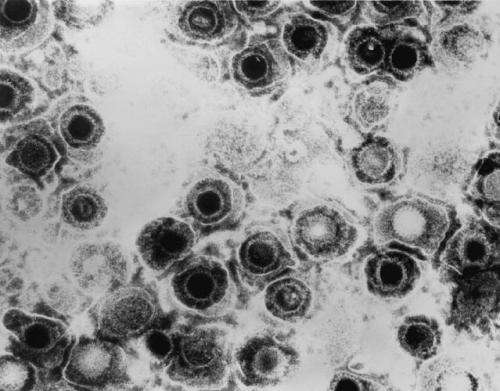
Researchers at Lund University in Sweden have discovered a new method to treat human herpes viruses. The new broad-spectrum method targets physical properties in the genome of the virus rather than viral proteins, which have previously been targeted. The treatment consists of new molecules that penetrate the protein shell of the virus and prevent genes from leaving the virus to infect the cell. It does not lead to resistance and acts independently of mutations in the genome of the virus. The results are published in the journal PLOS Pathogenes.
Herpes virus infections are lifelong, with latency periods between recurring reactivations, making treatment difficult. The major challenge lies in the fact that all existing antiviral drugs to treat herpes viruses lead to rapid development of resistance in patients with compromised immune systems where the need for herpes treatment is the greatest (e.g. newborn children, patients with HIV, cancer or who have undergone organ transplantation).
Both the molecular and physical properties of a virus determine the course of infection. However, the physical properties have so far received little attention, according to researcher Alex Evilevitch.
“We have a new and unique approach to studying viruses based on their specific physical properties. Our discovery marks a breakthrough in the development of antiviral drugs as it does not target specific viral proteins that can rapidly mutate, causing the development of drug resistance—something that remains unresolved by current antiviral drugs against herpes and other viruses. We hope that our research will contribute to the fight against viral infections that have so far been incurable,” says Alex Evilevitch, Associate Professor and senior lecturer at Lund University who, together with his research team, Virus Biophysics, has published the new findings.
The virus consists of a thin protein shell, a capsid, and inside it lies its genome, the genes. Alex Evilevitch has previously discovered that the herpes virus has high internal pressure because it is tightly packed with genetic material.
“The pressure is 20 atmospheres, which is four times higher than in a champagne bottle and this allows herpes viruses to infect a cell by ejecting its genes at high speed into the cell nucleus after the virus has entered the cell. The cell is then tricked into becoming a small virus factory that produces new viruses that can infect and kill other cells in the tissue, leading to different disease states,” explains Evilevitch.
He, with the help of preclinical studies at the National Institutes of Health in the United States, has identified small molecules that are able to penetrate the virus and “turn off” the pressure in the genome of the virus without damaging the cell. These molecules proved to have a strong antiviral effect that was several times higher than the standard treatment against certain herpes types with the drug Aciclovir, as well as against resistant herpesvirus strains where Aciclovir does not work. The approach prevented viral infection.
Since all types of herpes viruses have similar structure and physical properties, this antiviral treatment works on all types of viruses within the herpes family.
Source: Read Full Article
